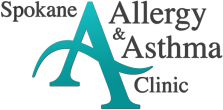Nasal Allergies
Why did I Develop a Nasal Allergy?
Allergic individuals have a familial (genetic) tendency to develop immunologic reactions to certa in protein particles, like dust – mite particles, animal danders, mold s pores or pollen grains . Once they are “sensitized”, these individuals will make allergic antibodies to these substance s . Then, future exposures will trigger an immunologic reaction in the nasal lining tissues. Sneezing, itching, watery discharge and nasal congestion are the result of locally – released histamine and other allergic mediators.
Not every allergic person is sensitive to the same protein particles, in fact, each allergic child or adult has an individual set of allergic sensitivities. The timing of their allergic symptoms may be a clue to your specific sensitivities.
- Year – round or perennial symptoms suggest a common daily exposure like housedust mites, molds, the dander of a household pet, or a common daily food. It could also reflect the daily irritation fro m domestic cigarette smoke or other indoor air pollutants.
- Seasonal (spring, summer, or autumn) symptoms are more typical of “Hayfever” and result from the pollens and molds that appear in the outdoor air. In this area, tree pollens are typical of the early spring, grass pollens in the late spring and early summer, and weed pollens in the later summer and early autumn.
- Many individuals have both year – round symptoms with definite seasonal peaks.
How can I Confirm that I have a Nasal Allergy?
A nasal allergy can best be confirmed by a careful history, a nasal smear for allergic inflammatory cells, called eosinophils, and selected skin tests to confirm suspected sensitivities. Skin tests are miniature allergic reactions that occur when a dust mite, animal dander, mold or pollen extract is pricked through the surface of the skin. Weakly positive reactions only suggest a possible allergy. A strongly positive skin test will usually confirm an important allergic sensitivity.
What are the Best Ways to Treat a Nasal Allergy?
The goal of any treatment plan for nasal allergies is to reduce the itching and congestion, and to avoid the possible complications of recurrent sinus and middle ear infections, and constant nasal obstruction. There are three treatment options: Avoidance, Medication and Allergy Shots.
- Avoidance of Environmental Allergens
- To decrease your nasal allergic inflammation, it is necessary to identify the specific allergic triggers and to remove them from your household and work environment. The better you are at this strategy, the less you have to consider medications and allergy shots. Several specific avoidance recommendations will be made after your initial allergy consultation.
- Medications
- Many allergic triggers cannot be entirely avoided. Most allergic individuals will also require some medications to treat continuing symptoms. There are five varieties of From the Spokane Allergy and Asthma Clinic medications : antihistamines, anti leukotrienes, decongestants, mast cell stabilize rs, and nasal steroids.
- Antihistamines
- Antihistamines are moderately effective for controlling the itch, drip, and sneeze of allergic rhinitis. With the exception of topical Astelin, the oral antihi stamines are not effective at treating congestion. We recommend that you avoid the “ first generation” oral antihistamines, most of which are now sold “over the counter” . These can have detrimental effects on daytime alertness, driving, and school and work performance . The intranasal antihistamine (Astelin) and “second generation” oral antihistamines (such as loratadine, Claritin, Allegra, and Zyrtec) are associated with less risk or no risk from sedation .
- Anti – leukotrienes
- Certain prescription asthma medicines known as anti – leukotrienes (Singulair and Accolate) have also been shown to improve nasal allergy symptoms. They can be as effective as antihistamines and are also nonsedating.
- Decongestants
- Oral decongestants ( pseudoephedrine , Sudaphed, phenylephrine , Sudaphe d PE) are available without prescription to treat symptomatic nasal and sinus congestion. They will not treat the drip, itch and sneeze symptoms . Topical decongestants (Afrin, Neosynephrine, etc.) are also available without prescription , but their use must be limited to only a few days at a time. Longer use will lead to “rebound” congestion.
- Mast Cell Stabilizers
- Nasal cromolyn (NasalCrom) is available without prescription for “pre – treatment” of allergic exposures. It has a shor t duration of action and must be used several times daily for ongoing symptoms. It is also without any significant side effects.
- Nasal Corticosteroids
- Nasal corticosteroids are the most effective prescription medication for controlling all of the symptoms of allergic rhinitis . They will often work when the other medications fail. These agents are generally not associated with significant side effects. Local nasal irritation and bleeding may occur. This usually resolves after you stop the treatments for a few days. Then you can resume regular use . In children, some of the older steroid sprays have been associated with a slight degree of growth suppression. This has not occurred with the newer preparations.
- Antihistamines
- Many allergic triggers cannot be entirely avoided. Most allergic individuals will also require some medications to treat continuing symptoms. There are five varieties of From the Spokane Allergy and Asthma Clinic medications : antihistamines, anti leukotrienes, decongestants, mast cell stabilize rs, and nasal steroids.
- Allergy Shots
- If your nasal allergies are not fully treated by avoidance and medications , or if there is an intolerance to the medications, your allergy specialist may advise allergy injection therapy. This form of desensitization therapy can be very effective at reducing your specific sensitivities. It is described in more detail in a separate handout.


